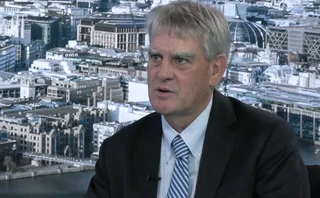
Deal of the year: UBS
Structured Products Europe Awards 2017: Swiss bank has ingeniously projected hedge fund strategies through structured products to offer great returns at a lower cost

With its relative value opportunities (RVO) programme, UBS has married the convenience and transparency of structured products with the kind of investment idea generation that, hitherto, has typically been accessible only through hedge funds. The programme allows the Swiss bank’s private wealth clients to access short-term, macro trading opportunities on an ad hoc, modular basis, and has seen it take this year’s deal of the year award.
“For a long time, structured products have been seen as a means of delivering ideas to private banking or retail clients,” says Ahmad Chaudry, head of solutions structuring at UBS Investment Bank in London. “Now, we’ve taken that structured products wrapper and delivered truly institutional intellectual content.”
The programme, which UBS began designing in 2015 and launched last year, brings together its investment bank and wealth management arm. The starting point is a series of investment ideas generated by the UBS Wealth Management chief investment office’s short-term opportunities team.
Led by Vinay Pande, the team joined UBS last year from hedge fund Brevan Howard, where it ran a global macro fund. Prior to that, it functioned as the institutional strategy group at Deutsche Bank. The team seeks out macro investing and tactical trading opportunities across more than 150 markets, exploiting inter-asset correlation to enhance returns.
“Our approach is valuation driven and macro informed,” says Pande. “Valuation without regard to the macro horizon is meaningless, and macro without regard to what sort of outcomes are already priced in is not very useful.”
It manages its approach by surveying the entire universe of liquid assets globally, across all traded asset classes, “seeking the most asymmetric long/short valuation opportunities” – that is, constructing trades where the long position has relatively unconstrained upside, and limited downside, and vice versa for the short leg.
“The combination is very powerful… Combining them, you will likely outperform the market, with lower volatility,” says Pande.
These investment ideas are analysed, stress-tested and priced, and termsheets are drafted, which – unlike a comparable hedge fund trade – provide transparency into the features of each certificate, such as the leverage used, the stop-loss triggers and the target return triggers, says Chaudry. The opportunity is presented in a note to UBS wealth management clients that sets out the economic rationale alongside an investible product. The whole process takes between 24 and 48 hours.
Investors are demanding better quality content and returns for lower fees
Ahmad Chaudry, UBS Investment Bank
“It’s all down to the platform and our ability to take an idea and turn it into something investible using a scaleable process,” he adds.
For each investment idea, UBS issues six certificates – three each for discretionary and advisory mandates, in dollars, euros and Swiss francs. That would not be possible in a mutual fund structure, Chaudry says, given the legal and documentation costs. Investors are able to buy the certificates individually or via a top-level certificate that invests in all the separate trades.
In addition, each trade includes a protection level – typically 60–75% of the notional. This allows investors to secure a high level of financing against their investments compared with hedge funds.
“Banks will lend 0–50% loan to value against a hedge fund,” says Chaudry. For a certificate with 75% protection, that figure would be more like 70%, he says.
The programme is available for an all-in fee of 1%, which compares favourably with the so-called ‘two and 20’ combination of management and performance fees typically charged by hedge fund managers.
“Investors are demanding better quality content and returns for lower fees,” notes Chaudry. Launching a programme to offer clients these investment products helps to keep costs down, while allowing the bank to scale up the offering.
“The aim of the programme is not to maximise the value to UBS per dollar of investment, but to maximise the volume of investment that goes into it,” he says.
Since the launch of the programme in mid-2016, more than $1.3 billion has been invested in around 250 certificates issued. As a whole, it has delivered 6%-plus annualised performance after fees, with around two-thirds of the ideas in the black. But the average conceals some standout trades – in both directions.
For example, the bank reports a trade in late 2016 that went long Russian equities and short Brazil and generated an internal rate of return of 148.9%. It took advantage of the effect of the rally in oil prices on the oversold Russian market, compared with the performance and effects of metals and grains prices in Brazil, and the ebbing of market relief at the impeachment of the country’s president, Dilma Rousseff, a few months previously.
The team has also had success with trades around Brexit and the election of Donald Trump to the US presidency – the latter generated an internal rate of return of 82.3% by going long US equities and shorting 10-year US Treasuries. While a Clinton win would have probably boosted equities at the expense of the bond market, an unexpected Trump victory was also seen as fiscally expansionary, given likely tax cuts, thereby hammering the bond market further.
“In the base case [a Clinton win], it does well; in the non-base case, it does better,” says Pande. “We always look at alternative scenarios.”
Delivering such investment opportunities with attractive fees to structured product clients has required considerable organisational and technological co-ordination. “This took an immense amount of collaboration across the various divisions involved,” says Chaudry.
Only users who have a paid subscription or are part of a corporate subscription are able to print or copy content.
To access these options, along with all other subscription benefits, please contact info@risk.net or view our subscription options here: http://subscriptions.risk.net/subscribe
You are currently unable to print this content. Please contact info@risk.net to find out more.
You are currently unable to copy this content. Please contact info@risk.net to find out more.
Copyright Infopro Digital Limited. All rights reserved.
As outlined in our terms and conditions, https://www.infopro-digital.com/terms-and-conditions/subscriptions/ (point 2.4), printing is limited to a single copy.
If you would like to purchase additional rights please email info@risk.net
Copyright Infopro Digital Limited. All rights reserved.
You may share this content using our article tools. As outlined in our terms and conditions, https://www.infopro-digital.com/terms-and-conditions/subscriptions/ (clause 2.4), an Authorised User may only make one copy of the materials for their own personal use. You must also comply with the restrictions in clause 2.5.
If you would like to purchase additional rights please email info@risk.net
More on Awards
Collateral management and optimisation product of the year: CloudMargin
Delivering the modern blueprint for enterprise collateral resilience
Flow market-maker of the year: Citadel Securities
Risk Awards 2026: No financing; no long-dated swaps? “No distractions,” says Esposito
Pricing and analytics: fixed income – Quantifi
Quantifi delivers high-performance, transparent and adaptable pricing and risk analytics for fixed income and credit markets
Derivatives house of the year: Citi
Risk Awards 2026: Rev up, RWAs down, as US bank gets back on track (with added XiNG and XiP)
Technology vendor of the year: SS&C Algorithmics
Risk Awards 2026: From cloud, to chips, to maths tricks – vendor getting more out of existing tech
SS&C Algorithmics: winner’s interview with Curt Burmeister
SS&C Algorithmics wins three categories in this year’s Markets Technology Awards in addition to Technology vendor of the year at the Risk Awards
Best vendor for system support and implementation: Murex
Murex wins Best vendor for system support and implementation at the Markets Technology Awards 2026
Pricing and analytics: cross-asset and structured – Murex
Murex wins Pricing and analytics: cross-asset and structured at the Markets Technology Awards 2026 thanks to its MX.3 platform







